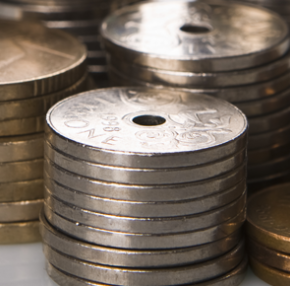Price increase in PPI by year’s end
Published:
The producer price index (PPI) increased by 1.6 percent in December. An increase in prices on several energy goods contributed to this increase. The price decrease in some manufacturing industries dampened the increase in PPI.
- Full set of figures
- Producer price index
- Series archive
- Producer price index (archive)
If one excludes energy goods, PPI showed a small downturn of 0.3 percent. Prices on energy goods in total ended with an increase of 4.4 percent, according to new figures from the Producer price index.. An important contributor here came from electricity, gas and steam. Prices here increased by 19.8 percent in December. According to their weekly reports (in Norwegian), the Norwegian Water Resources and Energy Directorate (NVE), the increase came as a result of several factors. The new connection NordLink between Norway and Germany came in use. This, together with fulfillment of reparations on other connections, increased export and thus prices. At the end of the month did lower temperatures increase prices further.
When it comes to prices on crude oil and natural gas, it was a divergence. The price on crude oil gained a larger increase in December than in November, whereas the natural gas prices dropped some. Combined, these two got a positive price change of 2.3 percent. Services related to these two industries, however, had a downturn of 2.7 percent. The last segment of the energy goods, refined petroleum products, went up 3.8 percent.
Figure 1. Price index. 2015=100
| Energy goods | PPI excluding energy goods | |
| Jan. 2015 | 99.63 | 100.35 |
| Feb. 2015 | 103.88 | 100.46 |
| Mar. 2015 | 106.96 | 100.16 |
| Apr. 2015 | 107.36 | 99.83 |
| May 2015 | 107.66 | 99.43 |
| June 2015 | 108.23 | 99.48 |
| July 2015 | 103.09 | 99.71 |
| Aug. 2015 | 94 | 99.84 |
| Sep. 2015 | 93.66 | 99.8 |
| Oct. 2015 | 94.85 | 99.76 |
| Nov. 2015 | 94.82 | 100.6 |
| Dec. 2015 | 85.85 | 100.59 |
| Jan. 2016 | 77.74 | 100.32 |
| Feb. 2016 | 72.93 | 100.41 |
| Mar. 2016 | 75.13 | 100.41 |
| Apr. 2016 | 76.59 | 100.29 |
| May 2016 | 81.33 | 100.44 |
| June 2016 | 86.65 | 100.3 |
| July 2016 | 87.27 | 100.45 |
| Aug. 2016 | 83.9 | 100.49 |
| Sep. 2016 | 81.95 | 99.55 |
| Oct. 2016 | 86.73 | 98.83 |
| Nov. 2016 | 91.41 | 98.84 |
| Dec. 2016 | 100.84 | 99.26 |
| Jan. 2017 | 101.31 | 99.46 |
| Feb. 2017 | 106.37 | 100.48 |
| Mar. 2017 | 103.81 | 100.5 |
| Apr. 2017 | 97.99 | 101.04 |
| May 2017 | 95.48 | 101.45 |
| June 2017 | 90.14 | 100.98 |
| July 2017 | 87.77 | 101.08 |
| Aug. 2017 | 89.01 | 100.9 |
| Sep. 2017 | 95.99 | 100.56 |
| Oct. 2017 | 102.3 | 100.18 |
| Nov. 2017 | 108.55 | 101.27 |
| Dec. 2017 | 115.99 | 101.02 |
| Jan. 2018 | 121.7 | 102.6 |
| Feb. 2018 | 114.42 | 103.08 |
| Mar. 2018 | 116.21 | 102.72 |
| Apr. 2018 | 124.58 | 102.77 |
| May 2018 | 126.75 | 103.48 |
| June 2018 | 132.44 | 103.6 |
| July 2018 | 135.4 | 103.67 |
| Aug. 2018 | 136.68 | 103.84 |
| Sep. 2018 | 140.56 | 104.01 |
| Oct. 2018 | 150.34 | 104.33 |
| Nov. 2018 | 141.52 | 104.12 |
| Dec. 2018 | 131.52 | 104.13 |
| Jan. 2019 | 130.64 | 105.57 |
| Feb. 2019 | 131.94 | 105.44 |
| Mar. 2019 | 126.44 | 105.61 |
| Apr. 2019 | 127.88 | 105.87 |
| May 2019 | 125.34 | 105.91 |
| June 2019 | 112.21 | 106.72 |
| July 2019 | 108.73 | 107.15 |
| Aug. 2019 | 108.16 | 107.1 |
| Sep. 2019 | 107.53 | 107.69 |
| Oct. 2019 | 107.44 | 107.95 |
| Nov. 2019 | 112.28 | 107.23 |
| Dec. 2019 | 120.93 | 108.29 |
| Jan. 2020 | 117.69 | 107.94 |
| Feb. 2020 | 107.06 | 109.1 |
| Mar. 2020 | 87.07 | 109.52 |
| Apr. 2020 | 75.69 | 112.06 |
| May 2020 | 70.07 | 111.48 |
| June 2020 | 69.43 | 109.91 |
| July 2020 | 69.36 | 109.92 |
| Aug. 2020 | 72.66 | 109.58 |
| Sep. 2020 | 77.93 | 110.15 |
| Oct. 2020 | 86.85 | 110.74 |
| Nov. 2020 | 97.36 | 111.04 |
| Dec. 2020 | 101.7 | 110.73 |
Weak increases within manufacturing
Prices within manufacturing increased by 0.3 percent in December. This modest increase was not uniform but came because of increases and decreases distributed amongst different industries.
On the upside we find the metal industry, which had an increase of 2.1 percent from November. The price increase came from high export prices on non-ferrous metals such as aluminum and zinc. This is despite a strengthened NOK against several foreign currencies. Also, iron and steel products had an increase. Mineral product industry also has an increase, with 2.4 percent.
Among the manufacturing industries with negative price development, one can mention the chemical industry with a downturn of 1.3 percent. This was joined by industries related to electronic and optical products and the metal products industry, with decreases of 1.6 percent and 0.9 percent, respectively. Also, the large industry of food products had a downturn, of 0.6 percent. Here seafood was important in the decrease, especially on the export market.
PPI through 2020
It has been a year marked by uneasy international and domestic markets due to several events such as the pandemic and the US presidential election. It is then time to sum up how the index have been in the year as a whole.
The yearly decrease in the index between 2019 and 2020 was at 10.2 percent. This is the largest yearly decrease in PPI since a larger restructuring of the index in 2001. Two large contributors to the downturn has come from the oil and gas industries as well as from electricity, gas and steam. These have had a yearly decrease in prices of 29.6 percent and 27.4 percent, respectively. A strong dampening effect in PPI for the year as a whole has been the food industry. This large industry ended up with a yearly increase of 3.0 percent
Fact sheet
Contact
-
Håvard Georg Jensen
-
Kristin Johansen
-
Elisabeth Mælum
-
Statistics Norway's Information Centre



